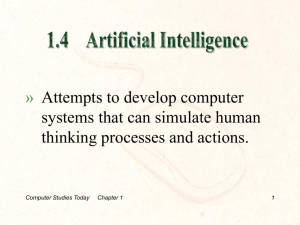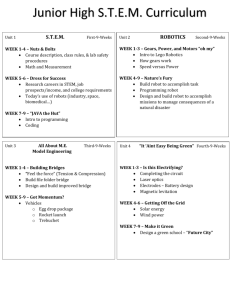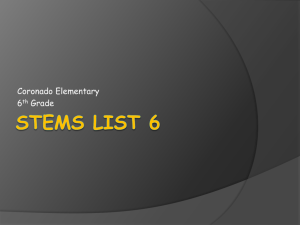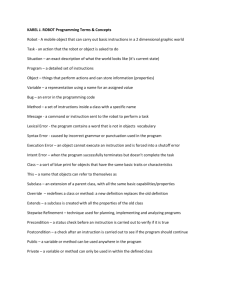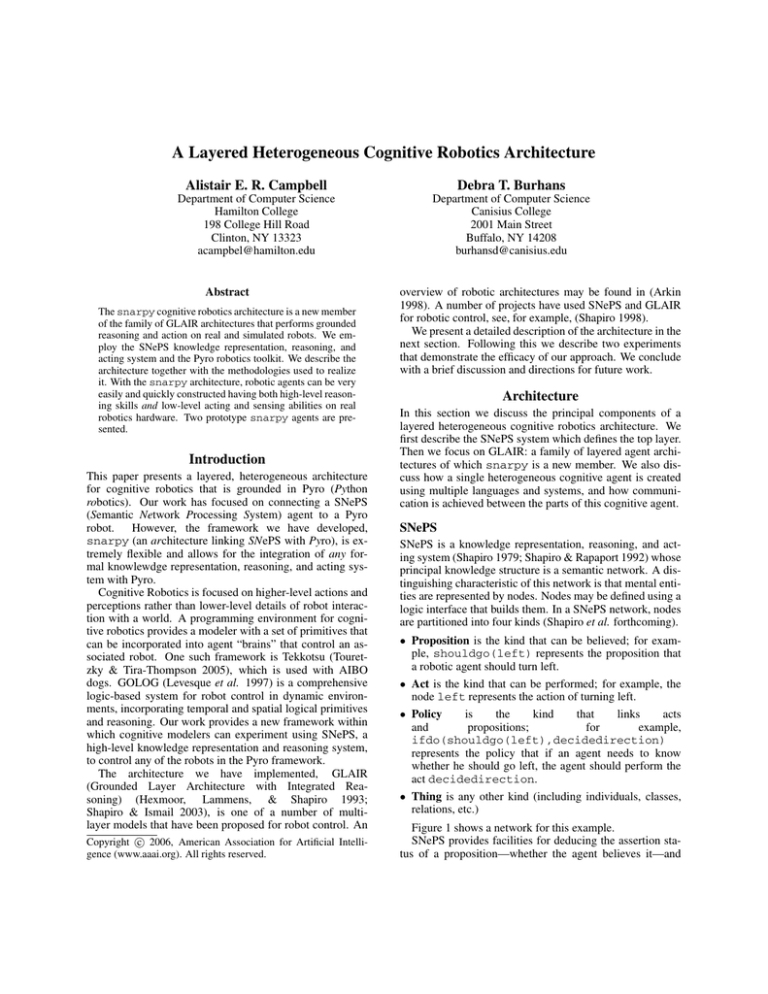
A Layered Heterogeneous Cognitive Robotics Architecture
Alistair E. R. Campbell
Debra T. Burhans
Department of Computer Science
Hamilton College
198 College Hill Road
Clinton, NY 13323
acampbel@hamilton.edu
Department of Computer Science
Canisius College
2001 Main Street
Buffalo, NY 14208
burhansd@canisius.edu
Abstract
The snarpy cognitive robotics architecture is a new member
of the family of GLAIR architectures that performs grounded
reasoning and action on real and simulated robots. We employ the SNePS knowledge representation, reasoning, and
acting system and the Pyro robotics toolkit. We describe the
architecture together with the methodologies used to realize
it. With the snarpy architecture, robotic agents can be very
easily and quickly constructed having both high-level reasoning skills and low-level acting and sensing abilities on real
robotics hardware. Two prototype snarpy agents are presented.
Introduction
This paper presents a layered, heterogeneous architecture
for cognitive robotics that is grounded in Pyro (Python
robotics). Our work has focused on connecting a SNePS
(Semantic Network Processing System) agent to a Pyro
robot.
However, the framework we have developed,
snarpy (an architecture linking SNePS with Pyro), is extremely flexible and allows for the integration of any formal knowlewdge representation, reasoning, and acting system with Pyro.
Cognitive Robotics is focused on higher-level actions and
perceptions rather than lower-level details of robot interaction with a world. A programming environment for cognitive robotics provides a modeler with a set of primitives that
can be incorporated into agent “brains” that control an associated robot. One such framework is Tekkotsu (Touretzky & Tira-Thompson 2005), which is used with AIBO
dogs. GOLOG (Levesque et al. 1997) is a comprehensive
logic-based system for robot control in dynamic environments, incorporating temporal and spatial logical primitives
and reasoning. Our work provides a new framework within
which cognitive modelers can experiment using SNePS, a
high-level knowledge representation and reasoning system,
to control any of the robots in the Pyro framework.
The architecture we have implemented, GLAIR
(Grounded Layer Architecture with Integrated Reasoning) (Hexmoor, Lammens, & Shapiro 1993;
Shapiro & Ismail 2003), is one of a number of multilayer models that have been proposed for robot control. An
c 2006, American Association for Artificial IntelliCopyright gence (www.aaai.org). All rights reserved.
overview of robotic architectures may be found in (Arkin
1998). A number of projects have used SNePS and GLAIR
for robotic control, see, for example, (Shapiro 1998).
We present a detailed description of the architecture in the
next section. Following this we describe two experiments
that demonstrate the efficacy of our approach. We conclude
with a brief discussion and directions for future work.
Architecture
In this section we discuss the principal components of a
layered heterogeneous cognitive robotics architecture. We
first describe the SNePS system which defines the top layer.
Then we focus on GLAIR: a family of layered agent architectures of which snarpy is a new member. We also discuss how a single heterogeneous cognitive agent is created
using multiple languages and systems, and how communication is achieved between the parts of this cognitive agent.
SNePS
SNePS is a knowledge representation, reasoning, and acting system (Shapiro 1979; Shapiro & Rapaport 1992) whose
principal knowledge structure is a semantic network. A distinguishing characteristic of this network is that mental entities are represented by nodes. Nodes may be defined using a
logic interface that builds them. In a SNePS network, nodes
are partitioned into four kinds (Shapiro et al. forthcoming).
• Proposition is the kind that can be believed; for example, shouldgo(left) represents the proposition that
a robotic agent should turn left.
• Act is the kind that can be performed; for example, the
node left represents the action of turning left.
• Policy
is
the
kind
that
links
acts
and
propositions;
for
example,
ifdo(shouldgo(left),decidedirection)
represents the policy that if an agent needs to know
whether he should go left, the agent should perform the
act decidedirection.
• Thing is any other kind (including individuals, classes,
relations, etc.)
Figure 1 shows a network for this example.
SNePS provides facilities for deducing the assertion status of a proposition—whether the agent believes it—and
for performing arbitrarily complex mental and physical acts.
SNePS operates in an open world: a proposition may be asserted, its negation may be asserted, neither, or even both, in
which case SNePS can signal a contradictory belief space,
giving options including the choice to continue deduction in
the presence of the contradiction without the risk that many
traditional systems pose: that of inferring any proposition
whatsoever. This gives a SNePS-using cognitive robot robust abilities to perform hypothetical reasoning in multiple
belief spaces (Shapiro 1993; Chalupsky & Shapiro 1994;
Johnson & Shapiro 2005a; 2005b).
In addition, SNePS has an integrated facility for acting and inference (Kumar 1996; Kumar & Shapiro 1994a;
1994b). For example, an agent implemented in the SNePS
system may perform the act believe(x), which is a mental action that causes a change in x’s assertion status for the
agent. Preconditions and effects of actions are computed
in the course of acting. For example, one effect of believe(x) is that the assertion of x’s negation is removed,
and x is asserted.
Two basic sorts of acts are primitive acts and composite
acts. Primitive acts are usually defined by the agent designer,
but some, such as believe, are pre-defined. SNePS provides built-in facilities for constructing new composite acts
from other acts. Three of the constructs that are of particular
use in our current snarpy systems are
• snsequence(a1,a2) is the composite act whose performance consists of performing a1 and then performing
a2.
• withall(?x,p(?x),a(?x),da) is the composite
act whose performance consists of deducing all entities
?x such that proposition p(?x) holds, and performing
act a(?x) on each such ?x in a non-deterministic order.
If no such ?x can be deduced, the default act da is performed.
• withsome(?x,p(?x),a(?x),da) is the composite
act whose performance consists of deducing all entities
?x such that p(?x) holds, non-deterministically choosing one of them, and performing act a(?x) on it. If there
are no entities satisfying p(?x), the default act da is performed.
There is also a facility for naming composite acts:
• ActPlan(a,p) Is the proposition that a plan for performing the named act a is to perform the (usually composite) act p.
GLAIR
In the Grounded Layered Architecture with Integrated Reasoning (GLAIR) family of cognitive robotics architectures
(Hexmoor, Lammens, & Shapiro 1993; Shapiro & Ismail
2003; Shapiro & Kandefer 2005), a robotic agent is realized
in 5 distinct layers of processing. The top layer is where
conscious reasoning and acting decisions occur. The lowest
layer is where the agent physically operates in its environment. The layers in between serve to mediate and translate high-level decisions to actuators and sensors. A GLAIR
Figure 1:
M1:
shouldgo(left):
The
proposition that the robot should go left; M2:
ifdo(shouldgo(left),decidedirection):
the policy that in order to determine whether the robot
should go left, the robot should perform a decidedirection action
system may encompass more than one concurrent computational process.
1. KL: the knowledge layer at which high-level conscious
decisions are made, and at which complex acts are
formulated and scheduled for execution. For example,
because there is an obstacle ahead and
to the right, turn left until the way
is clear to move forward is a KL reasoning
process and behavior. The KL is distinguished from
all other layers by being described entirely in terms
of well-formed-formulae in some logic, rather than in
terms of functions implemented in a computer programming language. In GLAIR agents, the KL is usually
implemented in SNePS.
2. PMLa: the primary perceptual-motor-layer at which are
implemented any unconscious actions requiring direct access to the KL. There are two basic kinds of actions here.
(a) control-processing algorithms (such as sequence, selection, iteration) organizing the lower-level agent behaviors in service of the KL decision. For example, if
an act has more than one applicable plan, this is the
layer at which a plan is selected. Or, if an action is to
be performed repeatedly, this is the layer at which the
repetition occurs until a condition is met.
(b) basic primitive actions which are executed by the
agent.
For example, select a motion direction among straight, hard-left,
left, and right is a PMLa primitive action
because it requires asserting the choice into the KL.
3. PMLb: the secondary perceptual-motor-layer at which
are implemented other algorithms which are needed in
service of higher-level PMLa actions. These algorithms
run in the same computational process as the KL but do
not require direct access to the KL structures. For example, start a hard left turn, wait 0.25
seconds, and stop turning is a PMLb primitive action which may be performed repeatedly in service
of the KL action example above. We also consider any facility that enables communication between a process implementing the higher layers of GLAIR and another process implementing the lower layers of GLAIR. Such a facility (for example, robotipc, described in detail below)
would be considered a PMLb construct.
4. PMLc: the tertiary perceptual-motor-layer at which behaviors at the layer above are realized on a particular
architecture. PMLc usually exists in an entirely different computational process, and may be implemented in
a different programming language, or even on a different computer. For example, A third-party robot control
program (such as Pyro) is a PMLc process in a GLAIR
system. This layer is responsible for executing an action such as set the rotational velocity to
120 degrees per second, implementing part of
the PMLb turning action example above. Another example might be determine the closest shade
(red, orange, yellow, etc) of the object the
robot is looking at, based on sensor data from the layer
below.
5. SAL: the sensory-actuator layer, at which robot hardware
motors are made to run, and at which sensors record and
return raw data to the layer above. The robot may be real
or simulated.
There is some flexibility in creating a robot from these
GLAIR layers. Whether a computation is done at PMLb
or PMLc is largely a matter of creative choice. For example, the problem of determining object shade could be
solved entirely at PMLc, entirely at PMLb (because a PMLc
process merely sends the raw data from SAL directly back
to PMLb), or, usually, partially at PMLc, and partially at
PMLb. Then, once PMLb determines the shade, the answer
is returned to PMLa for assertion at KL.
When considering whether a GLAIR agent is properly
called a “cognitive agent”, the degree to which the KL and
PMLa interact is critical.
Pyro
The Pyro toolkit is a Python-based, open source programming environment for robotics (Blank et al. 2006; Blank,
Meeden, & Kumar 2003; http://www.pyrorobotics.org ).
Pyro allows for the development of a variety of agents,
from simple reactive agents to neural network based learning agents. The Pyro framework provides underlying support for a variety of actual and simulated robots by providing a large set of high-level primitives for interacting with
sensors and effectors. The Pyro user is thus free to focus
on behavioral and cognitive issues in the design of agents.
Supported robots include the Khepera, Pioneer, and AIBO,
among others.
A Pyro “brain” comprises a Python program that interacts with a robot. This program accesses robot sensor data,
including vision if a camera is available for the robot, and
can issue commands that are associated with robot behaviors such as move, translate, and rotate. The default unit of
measure in a “world” is one robot unit, which corresponds
approximately to the diameter of the robot to which it refers.
Figure 2: The snarpy system: a GLAIR agent having concurrent processes controlling an AIBOTM robot dog
In theory, the same brain can be associated with a number of
different robots with few or no changes. This is the most
powerful feature of the Pyro framework. In practice this is
true as long as the robots share the same types of sensors
(e.g. range sensors) and the brain is written with enough
generality. However, even across different robot platforms
much of the code in a brain program will work for any supported robot.
While there has been significant focus on the use of
Pyro as an innovative and effective tool for teaching AI,
the toolkit also provides an ideal grounding for cognitive
robotics research. It is the linkage of sophisticated KR to
the Pyro system that comprises the primary contribution of
our work.
snarpy robots
Our cognitive robot is realized on a single computer in an
architecture involving two concurrent processes. The higher
brain is a Lisp process running SNePS; the lower brain is a
Python process running Pyro. The higher brain encompasses
the first three GLAIR layers: KL, PMLa, and the Lisp side
of PMLb. The lower brain encompasses the Python side of
PMLb, PMLc and SAL, including the robot machinery itself. Since Pyro conveniently abstracts away details of the
robot, it doesn’t matter to us whether the robot is real or
simulated.
Figure 2 shows the major components of snarpy. The
large gray rectangle on top represents the Lisp process; the
one on the bottom represents Python. The GLAIR software
layers are indicated with hashed regions and labeled. The
robot dog represents the SAL. While the figure includes an
AIBO robot it could be replaced by any of the robots supported by Pyro. Control is transferred from the SNePS system through the GLAIR layers to Pyro, which signals the
hardware, as follows:
1. The SNePS agent performs a high-level act.
2. The acting component of SNePS finds a detailed plan
for doing the act and organizes its performance through
PMLa.
3. Primitive unconscious actions are executed in PMLa and
PMLb, which result in requests sent through PMLb’s
robotipc interface (discussed below).
4. The PMLc.py brain for Pyro is simple. It repeatedly
queries its robotipc interface for messages from the higher
brain, and acts on them accordingly. Examples of two
kinds of messages PMLc can handle are shown below:
move(translate, rotate) for moving forward or backwards at speed translate (with 1 being full speed forward and -1 full speed backward) and rotate specifying
the speed and rotation direction. Pyro sets these velocities but makes no response to the higher brain.
distanceq(direction) for asking the distance to an obstacle in the specified direction ∈ {front,left-front,rightfront} based on the most recent range sensor values.
Pyro responds with the answer.
5. Any requirement for a particular robot acting or sensing
operation is determined by Pyro and sent from the host
computer to the actual hardware (SAL) by radio or other
signal as provided by the robot. Responses from the SAL
sensors are similarly received by Pyro and made available
to PMLc.
In our architecture, the robot acts according to cognitive
decisions made in the higher brain. An alternative architecture utilizing the same components could have a Python
brain in charge of the decisions (cognitive or otherwise)
but also use an external system for performing reasoning if
needed–a SNePS-based database or another agent perhaps.
In that case, control is transferred through the robotipc subsystem to query the external system. Pyro simply waits for a
response, and continues processing. Since a number of Pyro
brains have already been constructed it would be easier to
add a reasoner as an extra component to an existing brain
rather than mapping the brain functions onto an architecture
that requires the KL to be the driving process.
Brain communication via Robotipc
Communication between the higher and lower brain occurs
through a C program (mqI) that runs as a subprocess of each
brain component. The mqI program facilitates messagepassing via POSIX message queues. A simple protocol allows two processes to communicate by sending and receiving character string data. Once initialized, the C program is
responsible for allocating the queues and reading requests
from its parent process. The brain component interfaces
with mqI via the latter’s standard input and output, accessible to parent programming languages as file descriptors.
The protocol supports basic requests such as send and receive. For example, the send request is accomplished by
writing the word “SEND” followed by a string to be sent to
the other process. At startup, the mqI program reads three
important numbers—an agent number ∈ {0,1} representing
which brain component this instance of mqI is serving (e.g,
0=Higher, 1=Lower); and two positive integers: system level
identifiers of the message queues to be allocated and shared
between the processes (e.g. 500 and 501).
To access mqI, each brain component utilizes a package
or module called robotipc whose function are abstractions
of the basic requests. This way, the brain doesn’t have to be
concerned with actual message queue system calls, or with
the mqI protocol itself. Robotipc supports the following operations:
1. INITIALIZE: creates the mqI subprogram, gives it agent
and message queue numbers.
2. RECEIVE: blocks until a message has been sent by the
other process; returns the message.
3. SEND(message): sends message to the other process. If
the message queue is full, this operation will block until
the other process executes a receive operation.
4. QUERY: Returns true if a message has been sent by the
other process; false otherwise, i.e., if no message is waiting to be received.
5. SHUTDOWN: a request to shut down the mqI process,
severing communication with the other side of the brain.
While it is possible to implement interprocess communication routines directly in the Lisp and Python brain components, the use of auxillary processes facilitates more easily the connection of heterogeneous systems in general. In
many languages, directly accessing message queues requires
the using a foreign-function interface, which is generally
more complicated than creating a subprocess and performing I/O with its associated descriptors.
More importantly, with separate communication processes, the architecture does not depend on the use of SNePS
for the higher brain, or on Python for the lower brain. We
recognize that these components, whatever they are, may be
heterogeneous. Keeping the communication aspects separate from the brain reduces the burden on the brain.
Experiments
To test the feasibility of the snarpy architecture, we have
developed two cognitive robot control systems. The first
demonstrates the way in which an existing Pyro “brain” —
Avoid.py, included with Pyro — can be mapped onto the
proposed architecture and involves simple obstacle avoidance with a simulated Pioneer robot in a two-dimensional
world. The second involves using a single brain to evoke
the same behavior in two different robots: (a) the simulated
Pioneer and (b) a real AIBO dog.
Obstacle-avoid
The obstacle-avoid system ultimately controls a simulated
Pioneer robot. The agent’s basic cognitive process is simply
to repeat forever three sequential steps:
1. Decide on a direction to move
2. Move in that direction for a short period of time
3. Forget which direction you are moving
The knowledge level consists of the following logical assertions:
• Facts about what motion directions are possible:
possibledirection(hardturn).
possibledirection(right).
possibledirection(left).
possibledirection(straight).
• Two rules associated with moving: (1) a plan for performing a move action is to find some ?x such that
shouldgo(?x) is currently believed, and perform the
?x action. If no such ?x can be found, signal an error. (2)
to forgetdirection means to disbelieve every possible proposition of the form shouldgo(?x).
ActPlan(
move,
withsome(?x,shouldgo(?x),
action(?x),error)).
ActPlan(
forgetdirection,
withall(?x,possibledirection(?x),
disbelieve(shouldgo(?x)),
error))
• Higher-level behavior structures: (1) The act of taking
a single avoid step is to do, in sequence, the three
defined actions in the process. (2) The entire (infinite)
avoid act is to perform an avoidstep and repeat the
avoid.
ActPlan(
avoidstep,
snsequence(decidedirection,
snsequence(move,forgetdirection))).
ActPlan(avoid,
snsequence(avoidstep,avoid)).
The PMLa contains the following code.
In the
decidedirection primitive action, there are four possible motion decisions. We ask PMLb for the distances to
the obstacles in front of the robot. Then, based on the answers, we add one of four possible motion decisions to the
KL.1
1
The #!((...)) lines are written in traditional SNePS User
Language rather than in the SNePSLOG language employed elsewhere in this paper.
(define-primaction decidedirection ()
(let
((f (ask-distance "front"))
(fl (ask-distance "left-front"))
(fr (ask-distance "right-front")))
(cond ((< f 0.5)
#!((add shouldgo hardturn)))
((< fl 0.8)
#!((add shouldgo right)))
((< fr 0.8)
#!((add shouldgo left)))
(t
#!((add shouldgo
straight))))))
Each of the primitive actions is defined simply in terms
of a single PMLb-level operation: basic-move-step,
which takes translation and rotation velocities (in robotunits). The remaining PMLa primitive actions are shown
below:
(define-primaction hardturn ()
(basic-move-step 0.0 0.3))
(define-primaction right ()
(basic-move-step 0.1 -0.3))
(define-primaction left ()
(basic-move-step 0.1 0.3))
(define-primaction straight ()
(basic-move-step 0.5 0.0))
The PMLb, shown below, contains the code for the
basic-move-step function along with the code for
communicating with the PMLc (Pyro program).
(defun basic-move-step (trans rot)
(tell-move trans rot)
(sleep 0.25)
(defun ask-distance (direction)
(robotipc:send "DISTANCEQ")
(robotipc:send direction)
(read-from-string
(robotipc:receive)))
(defun tell-move (trans rot)
(robotipc:send "MOVE")
(robotipc:send
(format nil "˜A" trans))
(robotipc:send
(format nil "˜A" rot)))
The PMLc level is implemented as a Pyro brain. The
step function is automatically called by the Pyro system
10 times per second. The processDirective function
receives and acts upon messages from from PMLb: The
DISTANCEQ message computes and answers the smallest
distance from the robot to an obstacle along the requested
vector (front, left-front, or right-front). The
might have with its environment. The purpose of this experiment was simply to test the effects of running the same
brain on two very different robot platforms.
The agent’s basic cognitive process is simply to do the
cha-cha five times, where a cha-cha consists of a cha1 (move
forward one quarter robot length and pause) followed by a
cha2 (move backward one quarter robot length and pause).
In the simulated world the Pioneer can be observed moving foward and backward five times. Similarly, when the
AIBO dog controlled with the same brain (at all levels) the
dog moves foward and backward five times.
This experiment demonstrates the utility of Pyro as part
of the snarpy architecture.
Conclusion
Figure 3: Simple world created with the Stage simulator and
the Pioneer robot
MOVE message sets the physical robot in motion according
to received translation and rotation velocities.
def processDirective(self):
preface = robotipc.receive()
if preface == "DISTANCEQ":
vector = robotipc.receive()
distance =
min([s.distance()
for s in
self.robot.range
[vector]])
robotipc.send(str(distance))
elif preface == "MOVE":
trans = float(robotipc.receive())
rot = float(robotipc.receive())
self.robot.move(trans,rot)
def step(self):
if robotipc.query():
self.processDirective()
With all the layers in place, the simulated robot is set up
in an environment with walls and other obstacles. After the
user issues a perform avoid request to the KL, the robot
runs around forever in the room, turning as needed to the left
or right to avoid the obstacles. Figure 3 illustrates a simple
world in which the Pioneer avoid brain can be effectively
run.
AIBO-cha-cha
The cha-cha system can be used, without changes, to control
either a simulated Pioneer or a real AIBO robotic dog. This
is due to the fact that the system only involves forward and
backward movement and does not entail processing any sensor data. Note that the sensory capabilities of the AIBO and
Pioneer are very different and would have to be taken into
consideration in terms of the types of interactions the robot
We have introduced a new member of the GLAIR family
of cognitive robotics architectures. This work outlines the
principles of snarpy agents.
The architecture presented herein is not novel, rather, it
is the use of this architecture to connect a sophisticated KR
system to Pyro which is the primary contribution. In terms
of education, Pyro is being used by an increasing number of colleges and universities in introductory AI courses
to teach a variety of concepts, from vision and neural networks to basic robotics. Such courses often include instruction on knowledge representation. The framework we have
presented can easily be adapted to allow for the integration
of any KR system with Pyro robotics, thus facilitating the
integration of disparate instructional components of such
courses and letting students experience the importance of
KR in ”real-world” processing via robots. Traditional AI
courses may not include robotics or vision, but could quite
easily do so by using the framework we describe in this paper. Robotics has the potential to energize and excite students in terms of future study of computer science in general
and AI in particular: the system we present is easily accessible to students at many levels and to faculty without previous robotics experience. The simulated robots and worlds
in Pyro allow for the use of the framework in the complete
absence of real-world robots.
Pyro has received most attention in terms of teaching, but
it is also useful for research robotics, particularly cognitive
robotics, as it provides a cognitively motivated set of primitives that allow researchers whose focus is not on robot hardware to easily interface to actual robots. We have attempted
to show some of the features of Pyro by demonstrating the
use of the same Pyro brain in both a simulated Pioneer and
an Aibo dog. The examples we have presented are simple,
but they help to convey the potential power of the approach.
To better demonstrate the capabilities of this particular architecture (namely, the linkage of SNePS with Pyro), future agents we develop must have increased capabilities at
the knowledge level to make conscious decisions about actions and to forget about—more than merely disbelieve—
previously asserted propositions. Our next agents will connect to more interesting sensor and actuator interfaces in the
Pyro framework such as vision. By using SNePS at the top
of a layered architecture, Pyro cognitive robotic agents will
be able to reason, act, and respond to human queries about
what they know, what they have seen and what they have
done.
References
Arkin, R. C. 1998. Behavior-Based Robotics. MIT Press.
Blank, D.; Kumar, D.; Meeden, L.; and Yanco, H. 2006.
The Pyro toolkit for AI and robotics. AI Magazine 27(1).
special issue on robots and robotics in education.
Blank, D. S.; Meeden, L.; and Kumar, D. 2003. Python
robotics: An environment for exploring robotics beyond
legos. In ACM Special Interest Group: Computer Science
Education Conference.
Chalupsky, H., and Shapiro, S. C. 1994. Sl: A subjective,
intensional logic of belief. In Proceedings of the Sixteenth
Annual Conference of the Cognitive Science Society, 165–
170. Hillsdale, NJ: Lawrence Erlbaum.
Hexmoor, H.; Lammens, J.; and Shapiro, S. C. 1993. Embodiment in GLAIR: a grounded layered architecture with
integrated reasoning for autonomous agents. In Dankel II,
D. D., and Stewman, J., eds., Proceedings of The Sixth
Florida AI Research Symposium (FLAIRS 93), 383–404.
The Florida AI Research Society.
http://www.pyrorobotics.org. Pyro Website.
Johnson, F., and Shapiro, S. C. 2005a. Dependencydirected reconsideration: Belief base optimization for truth
maintenance systems. In Proceedings of the Twentieth
National Conference on Artificial Intelligence (AAAI-05).
Menlo Park, CA: AAAI Press.
Johnson, F., and Shapiro, S. C. 2005b. Improving recovery
for belief bases. In Morgenstern, L., and Pagnucco, M.,
eds., Proceedings of the Sixth Workshop on Nonmonotonic
Reasoning, Action, and Change. Edinburgh, Scotland: IJCAI.
Kumar, D., and Shapiro, S. C. 1994a. Acting in service of
inference (and vice versa). In Dankel II, D. D., ed., Proceedings of The Seventh Florida AI Research Symposium
(FLAIRS 94), 207–211. The Florida AI Research Society.
Kumar, D., and Shapiro, S. C. 1994b. The OK BDI architecture. International Journal on Artificial Intelligence
Tools 3(3):349–366.
Kumar, D. 1996. The SNePS BDI architecture. Decision
Support Systems 16(1):3–19.
Levesque, H.; Reiter, R.; Lespérance, Y.; Lin, F.; and
Scherl, R. 1997. GOLOG: A logic programming language for dynamic domains. Journal of Logic Programming 31:59–84.
Shapiro, S. C., and Ismail, H. O. 2003. Anchoring in
a grounded layered architecture with integrated reasoning.
Robotics and Autonomous Systems 43(2–3):97–108.
Shapiro, S. C., and Kandefer, M. 2005. A SNePS approach
to the wumpus world agent or cassie meets the wumpus. In
Morgenstern, L., and Pagnucco, M., eds., IJCAI-05 Workshop on Nonmonotonic Reasoning, Action, and Change
(NRAC’05): Working Notes, 96–103. Edinburgh, Scotland:
IJCAI.
Shapiro, S. C., and Rapaport, W. J. 1992. The SNePS
family. Computers & Mathematics with Applications 23(2–
5):243–275.
Shapiro, S. C.; Rapaport, W. J.; Kandefer, M.; Johnson,
F. L.; and Goldfain, A. forthcoming. Metacognition in
SNePS. AI Magazine.
Shapiro, S. C. 1979. The SNePS semantic network processing system. In Findler, N., ed., Associative Networks:
The Representation and Use of Knowledge by Computers.
New York: Academic Press. 179–203.
Shapiro, S. C. 1993. Belief spaces as sets of propositions.
Journal of Experimental and Theoretical Artificial Intelligence (JETAI) 5(2–3):225–235.
Shapiro, S. C. 1998. Embodied cassie. In Cognitive
Robotics: Papers from the 1998 AAAI Fall Symposium,
Technical Report FS-98-02. Menlo Park, California: AAAI
Press. 136–143.
Touretzky, D. S., and Tira-Thompson, E. J.
2005.
Tekkotsu: A framework for aibo cognitive robotics. In
AAAI, 1741–1742.

